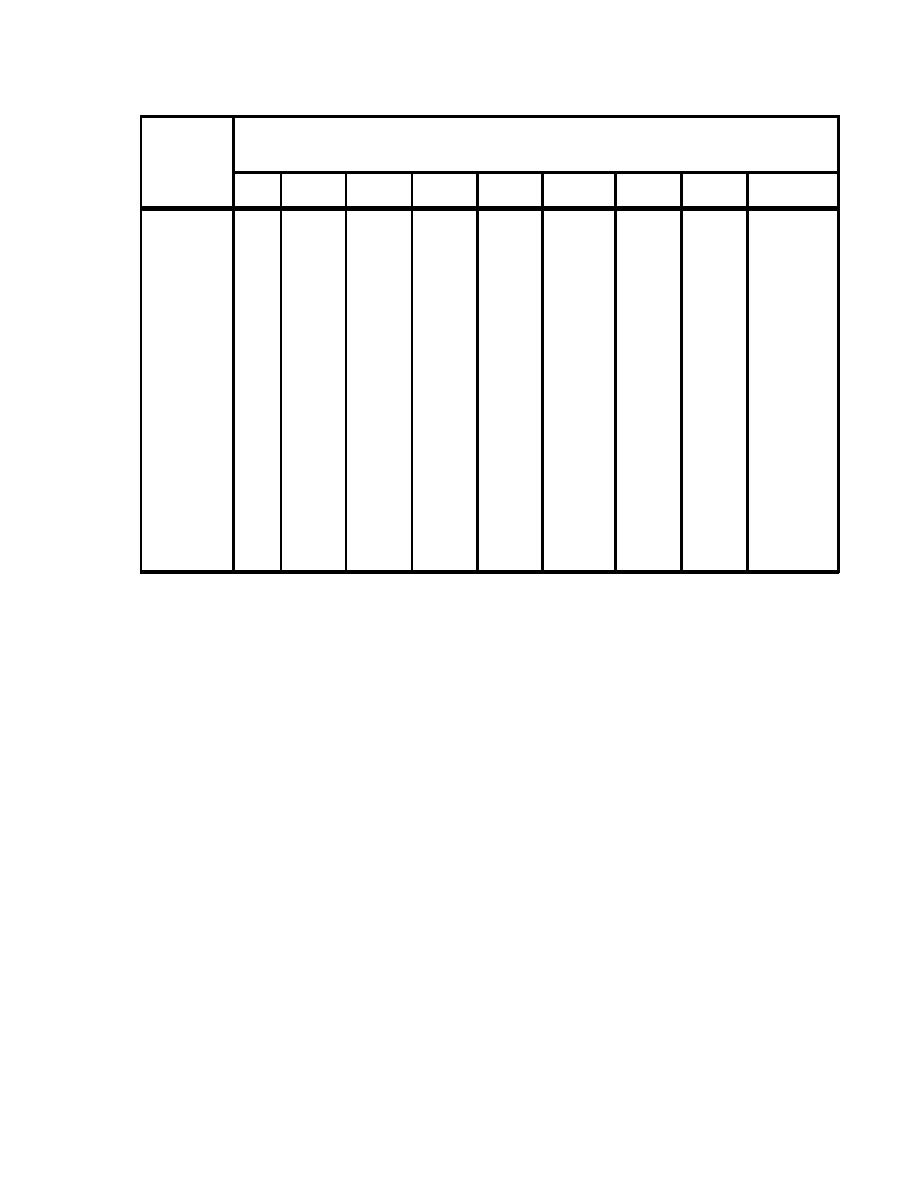
TM 5-805-4/AFJMAN 32-1090
Table 3-2. REL SPL Values for a Range of Distances "D" and Room Constants "R", for Use With PWL Data.
Room
Distance "D" (in ft.) from Equipment
Constant
"R"
(ft.2)
3
5
10
15
20
30
40
60
80
100
-3
-4
-4
-4
-4
-4
-4
-4
-4
200
-5
-6
-7
-7
-7
-7
-7
-7
-7
320
-6
-7
-8
-8
-9
-9
-9
-9
-9
500
-7
-9
-10
-11
-11
-11
-11
-11
-11
700
-8
-10
-12
-12
-12
-13
-13
-13
-13
1000
-8
-11
-13
-13
-14
-14
-15
-15
-15
2000
-9
-12
-15
-16
-17
-17
-17
-18
-18
3200
-10
-13
-16
-17
-18
-19
-19
-20
-20
5000
-10
-14
-17
-18
-20
-21
-21
-22
-23
-10
-14
-16
-19
-21
-22
-23
-24
-25
7000
10000
-10
-14
-19
-21
-22
-23
-24
-25
-26
20000
-10
-15
-20
-22
-24
-26
-27
-30
-30
Infinite
-10
-15
-21
-24
-27
-30
-33
-36
-39
above 1000 Hz). Therefore, the high-frequency
Room Constant. Part B of table 3-3 gives a
Room Constant obtained from figure 3-2 must be
multiplier for doing this.
reduced to apply to the lower frequencies. Part A
3-4. Sample Calculations.
of table 3-3 gives a multiplier for doing this. This
multiplier is a function of frequency, Noise Reduc-
Two sample calculations are provided, one in
tion Coefficient (NRC) range of any special sound
which the sound pressure level (SPL) for the
absorption material, and the mounting type for
equipment is provided and one where the sound
installing the absorption material. The Noise Re-
power level (PWL) is provided.
duction Coefficient is the arithmetic average of the
a. Sound pressure level provided. To illustrate
sound absorption coefficient at 250, 500, 1,000 and
use of equation 3-2, a piece of equipment is
2,000 Hz. Mounting type A consists of application
measured by a manufacturer under one set of
sound absorptive material applied directly onto a
conditions and is to be used by the customer under
hard backing such as a wall or ceiling. Mounting
an entirely different set of conditions. The data
type B consists of sound absorptive material me-
and calculations are summarized in table 3-5. The
chanically supported with a large air space behind
manufacturer's measurements, shown in column 2,
the material, such as a typical suspended ceiling.
are made at a 6-foot distance from the equipment
f. Use of Table 3-3, part B. Relatively thin wall
(here assumed nondirectional, that is, equal sound
materials (such as gypsum board, plaster, ply-
output in all directions) in a room whose Room
wood, and glass), even though not normally con-
Constants as a function of frequency are shown in
sidered as soft, porous, and absorptive, actually
column 3 of table 3-4. The customer is interested
have relatively large values of sound absorption
in the sound pressure levels at a 20-foot distance
coefficient at low frequency. This is because these
in a mechanical equipment room having the Room
thin surfaces are lightweight and are easily
Constant values shown in column 5. In applying
driven by airborne sound waves. For this reason
equation 3-2, D1 = 6 ft., D2 = 20 ft., R1 is given
they appear as effective sound absorbers at low
by the column 3 data, R2 is given in column 5, and
frequency, and this characteristic should be taken
the measured levels are listed in column 2. First,
into account in the calculation or estimation of
figure 3-1 is used to estimate the REL SPLD1R1
3-4


 Previous Page
Previous Page
